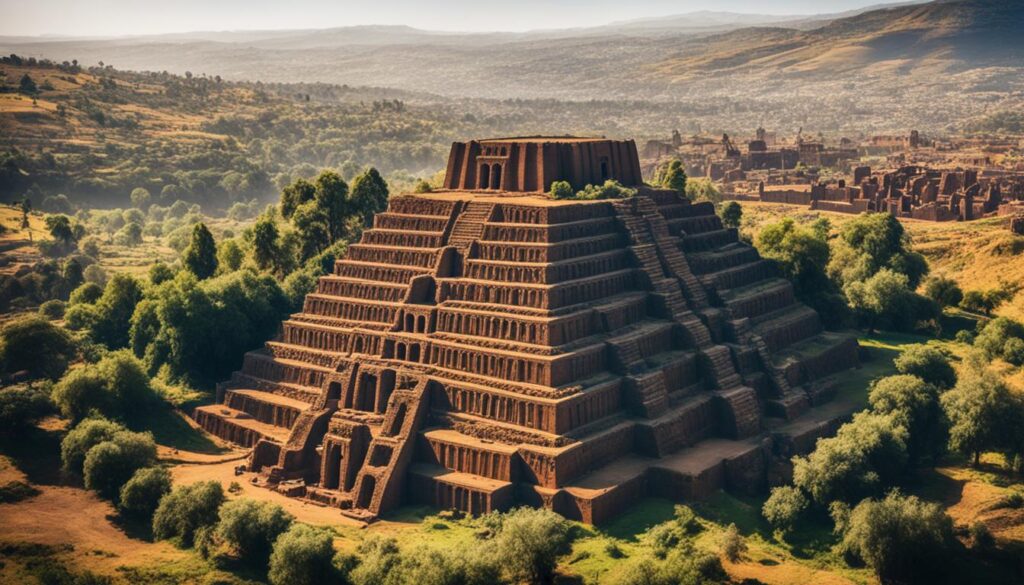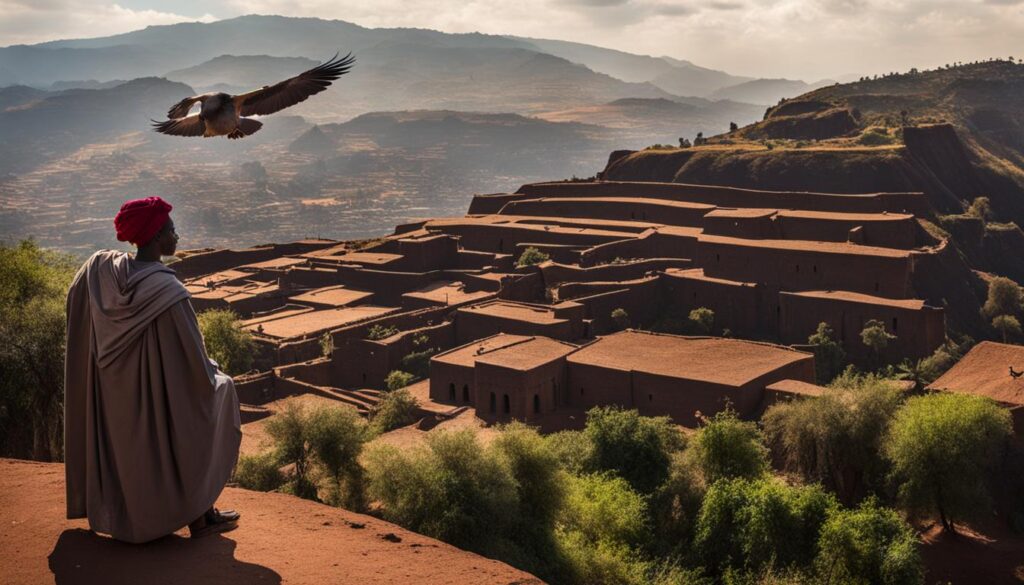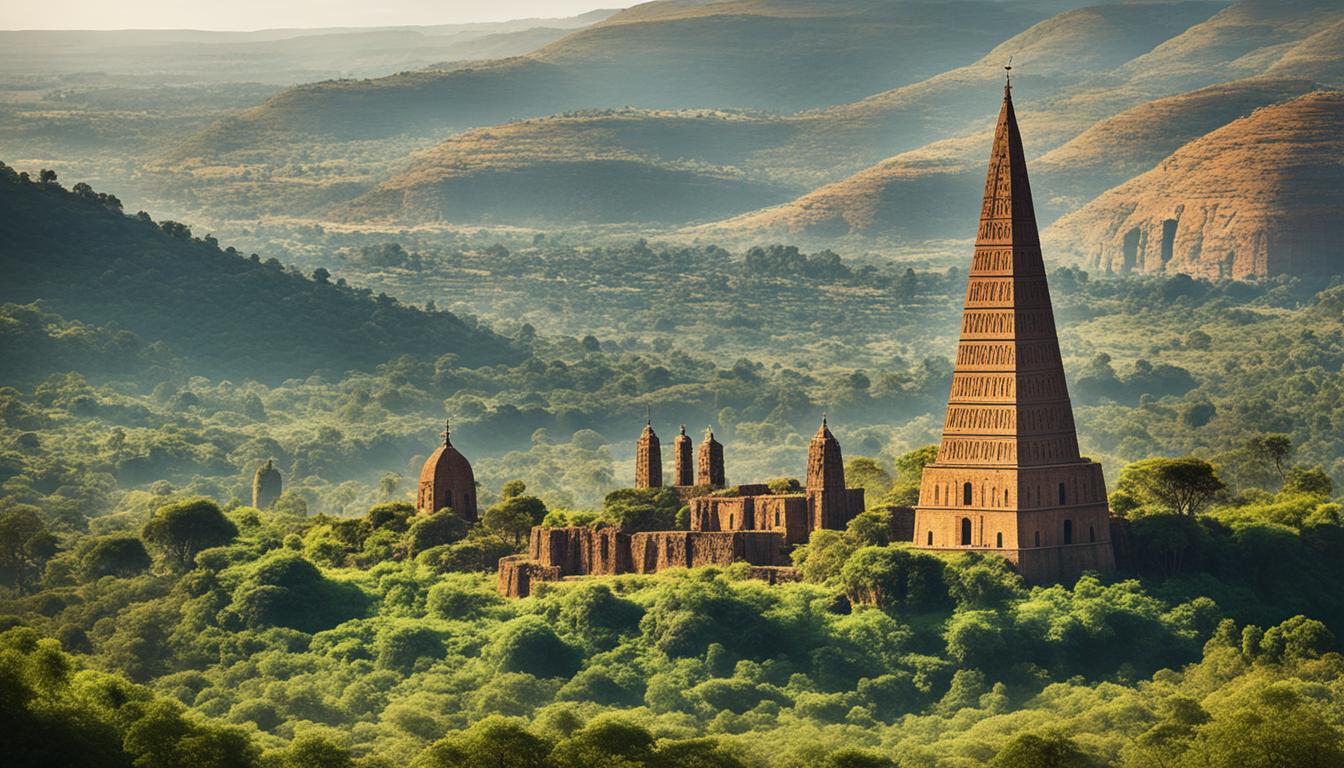Is Ethiopia the Oldest Country in the World?
Did you know that Ethiopia is believed to be one of the oldest countries in the world? With over 3,000 years of history, this African nation has a fascinating past that spans back to the emergence of anatomically modern humans. Located in the Horn of Africa region, Ethiopia’s ancient roots and historical landmarks tell a captivating story of civilization, culture, and heritage.
From the Kingdom of Aksum to the rock-hewn churches of Lalibela, Ethiopia’s historical significance cannot be understated. Join us as we explore the historical timeline, cultural heritage, and landmark sites that make Ethiopia a truly remarkable destination.
Key Takeaways:
- Ethiopia is believed to be one of the oldest countries in the world, with a history spanning over 3,000 years.
- The country’s ancient roots can be traced back to the emergence of anatomically modern humans.
- Ethiopia is home to historical landmarks such as the Kingdom of Aksum and the rock-hewn churches of Lalibela.
- The country’s diverse ethnic composition contributes to its vibrant cultural heritage.
- Ethiopia’s historical and cultural significance continues to attract tourists from around the world.
The Ancient Civilization of Ethiopia
Ethiopia boasts a fascinating history that stretches back to ancient times, with ancient civilizations that have shaped its culture and heritage. The timeline of Ethiopian civilization showcases the rise and fall of kingdoms, the adoption of prominent religions, and the enduring spirit of the Ethiopian people.
The Kingdom of D’mt
One of the earliest known civilizations in Ethiopia is the Kingdom of D’mt, which thrived around 980 BC. This kingdom extended its dominion over Eritrea and the northern region of Ethiopia, establishing a prominent presence in the area.
The Kingdom of Aksum
Following the Kingdom of D’mt, the Kingdom of Aksum emerged, maintaining a unified civilization in the region for 900 years. The Aksumites embraced Christianity in 330 AD, making Ethiopia one of the first countries to adopt this religion. Through their extensive trade networks, the Aksumites gained prosperity, with Aksum becoming a cosmopolitan city and a center of power in the region.
Arrival of Islam and the Zagwe Dynasty
In the 7th century, Islam arrived in Ethiopia through the first Hijra in 615 AD, leaving a lasting impact on the religious landscape of the country. Subsequently, the Zagwe dynasty came to power and ruled over the north-central parts of Ethiopia. During their reign, the Zagwe rulers contributed to the construction of remarkable religious structures, including the renowned rock-hewn churches of Lalibela.
| Period | Main Event |
|---|---|
| The Kingdom of D’mt | Thrived around 980 BC and extended its dominion over Eritrea and the northern region of Ethiopia |
| The Kingdom of Aksum | Maintained a unified civilization for 900 years and embraced Christianity in 330 AD |
| The Zagwe Dynasty | Ruled over the north-central parts of Ethiopia until overthrown in 1270 |
Ethiopian Empire and Zemene Mesafint
The overthrow of the Zagwe dynasty in 1270 marked the rise of the Ethiopian Empire under the leadership of Yekuno Amlak. The empire expanded through territorial conquests and engaged in conflicts with neighboring territories. However, internal conflicts and external pressures led to the fragmentation of the empire in the mid-18th century, resulting in a period known as Zemene Mesafint, characterized by decentralized rule and regional power struggles.
Reunification and Modernization
Emperor Tewodros II brought an end to the period of Zemene Mesafint in 1855. His reign marked the reunification and modernization of Ethiopia, leading to significant social, political, and economic reforms that shaped the country’s path towards the present day.
The Significance of Ethiopia’s Historical Landmarks

Ethiopia is home to several historical landmarks that hold great significance in the country’s history and culture. These landmarks not only showcase the architectural marvels but also provide valuable insights into Ethiopia’s rich cultural heritage.
The Kingdom of Aksum
The Kingdom of Aksum, with its obelisks and ancient ruins, is a UNESCO World Heritage Site and attracts tourists from around the world. These towering obelisks, carved from single blocks of stone, serve as a testament to the advanced engineering skills of the Aksumite civilization. They stand as enduring symbols of the kingdom’s power and influence.
Lalibela’s Rock-Hewn Churches
Lalibela is another UNESCO World Heritage Site and a major pilgrimage site for Ethiopian Orthodox Christians. The rock-hewn churches of Lalibela are exceptional architectural wonders carved directly into the solid rock. These churches are not only places of worship but also masterpieces of art and craftsmanship.
Axum, Gondar, and Harar
In addition to Aksum and Lalibela, Ethiopia boasts other cities that house historical sites and landmarks worth visiting. Axum, once the capital of the Aksumite Empire, has magnificent ruins and ancient artifacts that depict the kingdom’s prosperous past. Gondar, known as the “Camelot of Africa,” is famous for its well-preserved medieval castles and palaces. Harar, a UNESCO World Heritage Site, offers a glimpse into the unique and vibrant Islamic culture of Ethiopia.
Exploring these historical landmarks allows visitors to immerse themselves in Ethiopia’s past and appreciate the country’s rich cultural heritage. The intricate architecture, ancient artifacts, and religious significance of these sites offer a captivating experience that resonates with both history enthusiasts and those seeking to delve deeper into Ethiopian culture.
Ethiopia’s Ancient Roots and Cultural Heritage

Ethiopia’s ancient roots can be traced back to the origin of humans in the region. Known as the Cradle of Humanity, Ethiopia is believed to be one of the places where anatomically modern humans emerged. It is also proposed as a possible homeland of the Afroasiatic language family. The country’s diverse ethnic composition contributes to its vibrant cultural heritage, with each group having its own traditions, customs, languages, and music.
“Ethiopia’s rich cultural heritage is a tapestry woven with the threads of its ancient roots and diverse ethnic groups. This cultural tapestry encompasses a wide range of traditions, rituals, and artistic expressions that have been passed down through generations.”
From the Oromo people in the south to the Amhara and Tigray people in the north, Ethiopia’s cultural heritage is a mosaic of different practices and beliefs. The Ethiopian Orthodox Church, which has a long history in the country, is an integral part of the cultural fabric and plays a significant role in the lives of Ethiopians.
One of the key aspects of Ethiopia’s cultural heritage is its cuisine. Ethiopian food is known for its unique flavors and spices, drawing influences from various regions within the country. Injera, a sourdough flatbread, forms the base of many Ethiopian meals, which are often accompanied by a variety of stews and vegetables. This distinct culinary tradition is deeply rooted in Ethiopian culture and is celebrated both locally and internationally.
Ethiopian Cultural Heritage
| Ethnic Group | Traditions and Customs | Languages | Music and Dance |
|---|---|---|---|
| Oromo | Oromo Gada System, Irreechaa festival | Afaan Oromoo | Qeerroo music, Birmajii dance |
| Amhara | Timkat festival, Fasika (Easter) celebration | Amharic | Ethio-jazz, Eskista dance |
| Tigray | Debre Damo monastery, Ashenda festival | Tigrinya | Tigrigna music, Debubawi Hahu dance |
With its ancient roots and vibrant cultural heritage, Ethiopia stands as a testament to the diverse and resilient nature of human civilization. The preservation and celebration of its cultural traditions are not only significant for the people of Ethiopia but also offer valuable insights into the shared history of humanity.
Ethiopia’s Civilizational Timeline
Ethiopia’s historical journey spans thousands of years, shaped by the rise and fall of various kingdoms and empires. Let’s explore the significant periods that have contributed to Ethiopia’s rich history and cultural heritage.
The Kingdom of D’mt
The Kingdom of D’mt, dating back to around 980 BC, was an influential civilization that extended its rule over Eritrea and northern Ethiopia. It laid the foundation for future empires and established trade routes connecting the region to the Red Sea.
The Kingdom of Aksum
The Kingdom of Aksum emerged as a powerful civilization and reached its peak between the 1st and 8th centuries AD. It embraced Christianity in 330 and developed a unique form of architecture, including iconic obelisks and ancient ruins that still stand as a testament to its grandeur.
The Zagwe Dynasty
Following the Kingdom of Aksum, the Zagwe dynasty ruled over north-central Ethiopia for several centuries. This period witnessed the construction of magnificent rock-hewn churches in Lalibela, carving them out of solid volcanic rock.
The Ethiopian Empire
The Ethiopian Empire, founded by Emperor Yekuno Amlak in 1270, marked the reunification of Ethiopia. The empire had its zenith during the 14th century, expanding its territories through successful military campaigns. However, the empire’s decline began in the 16th century due to internal conflicts and external pressures.
Zemene Mesafint and Reunification
The 18th century witnessed a period of decentralization known as Zemene Mesafint, marked by fragmented rule and power struggles among regional warlords. It was Emperor Tewodros II in the 19th century who initiated modernization efforts and sought to reunify Ethiopia.
| Period | Main Features |
|---|---|
| The Kingdom of D’mt | Extended rule over Eritrea and northern Ethiopia Established trade routes |
| The Kingdom of Aksum | Embraced Christianity Constructed obelisks and ancient ruins |
| The Zagwe Dynasty | Carved rock-hewn churches in Lalibela |
| The Ethiopian Empire | Successful military campaigns Territorial expansion |
| Zemene Mesafint and Reunification | Period of decentralization Modernization and reunification efforts |
Ethiopia’s civilizational timeline is a testament to the resilience and endurance of its people. From the ancient Kingdom of D’mt to the powerful Ethiopian Empire, each era has left its mark on the country’s history, shaping its cultural heritage and providing valuable insights into its past.
Ethiopia’s Historical and Cultural Significance Today
Ethiopia continues to hold immense historical and cultural significance that resonates in the present day. This East African country boasts a rich tapestry of historical landmarks, which serve as testaments to its illustrious past and continue to captivate tourists and researchers alike. Among these landmarks are the world-renowned rock-hewn churches of Lalibela, an architectural marvel that symbolizes Ethiopia’s unique blend of religion and craftsmanship. The ancient ruins of Aksum, another notable site, stand as a testament to the former glory of the Kingdom of Aksum and its influence throughout the region.
But Ethiopia’s appeal extends beyond its historical landmarks. The country’s vibrant cultural heritage is celebrated through an array of festivals, music, dances, and traditional ceremonies. These events provide a glimpse into Ethiopia’s diverse ethnic groups, each with their own distinct customs and traditions. From the colorful celebrations of Timkat, Enkutatash, and Meskel to the rhythmic beats of traditional Ethiopian music, the culture of Ethiopia is alive and thriving.
“Ethiopia’s rich cultural heritage is a source of immense pride for its people and a source of fascination for visitors from around the world.”
Coffee also holds a special place in Ethiopian culture. As the birthplace of coffee, Ethiopia has a long-standing tradition of cultivating and brewing this beloved beverage. Coffee ceremonies, an integral part of Ethiopian hospitality, offer visitors an opportunity to experience the time-honored rituals and flavors that have shaped the country’s coffee culture.
Furthermore, the Ethiopian Orthodox Church plays a significant role in the lives of Ethiopians. With its ancient rituals, vibrant religious festivals, and breathtaking religious art, the church serves as a cornerstone of Ethiopian identity and spirituality.
Ethiopia’s historical and cultural significance not only contributes to its national identity but also fuels its burgeoning tourism industry. Travelers from around the globe flock to Ethiopia to immerse themselves in its rich history, vibrant culture, and breathtaking landscapes. By preserving and celebrating its past, Ethiopia ensures that future generations will continue to be enchanted by its remarkable heritage.
Conclusion
Ethiopia, with its ancient roots, historical landmarks, and rich cultural heritage, holds a prominent place in world history. As one of the oldest countries in the world, with over 3,000 years of history, Ethiopia has witnessed the rise and fall of civilizations, the spread of religions, and the development of unique cultural traditions.
Today, Ethiopia continues to preserve and celebrate its historical and cultural significance, attracting visitors from around the globe to experience its rich heritage. From the ancient ruins of the Kingdom of Aksum to the rock-hewn churches of Lalibela, Ethiopia’s historical landmarks offer a glimpse into the country’s storied past.
The diverse ethnic composition of Ethiopia contributes to its vibrant culture and heritage, with each group having its own traditions, customs, languages, and music. Ethiopian cuisine, with its unique flavors and spices, is an important aspect of the country’s cultural heritage. Additionally, Ethiopia’s civilizational timeline showcases the kingdom’s growth, decline, reunification, and modernization.
In conclusion, Ethiopia’s ancient roots, historical landmarks, and cultural heritage make it a truly remarkable country. Whether you’re interested in exploring its ancient history, experiencing its diverse traditions, or marveling at its architectural wonders, Ethiopia offers a fascinating journey through time and culture.






